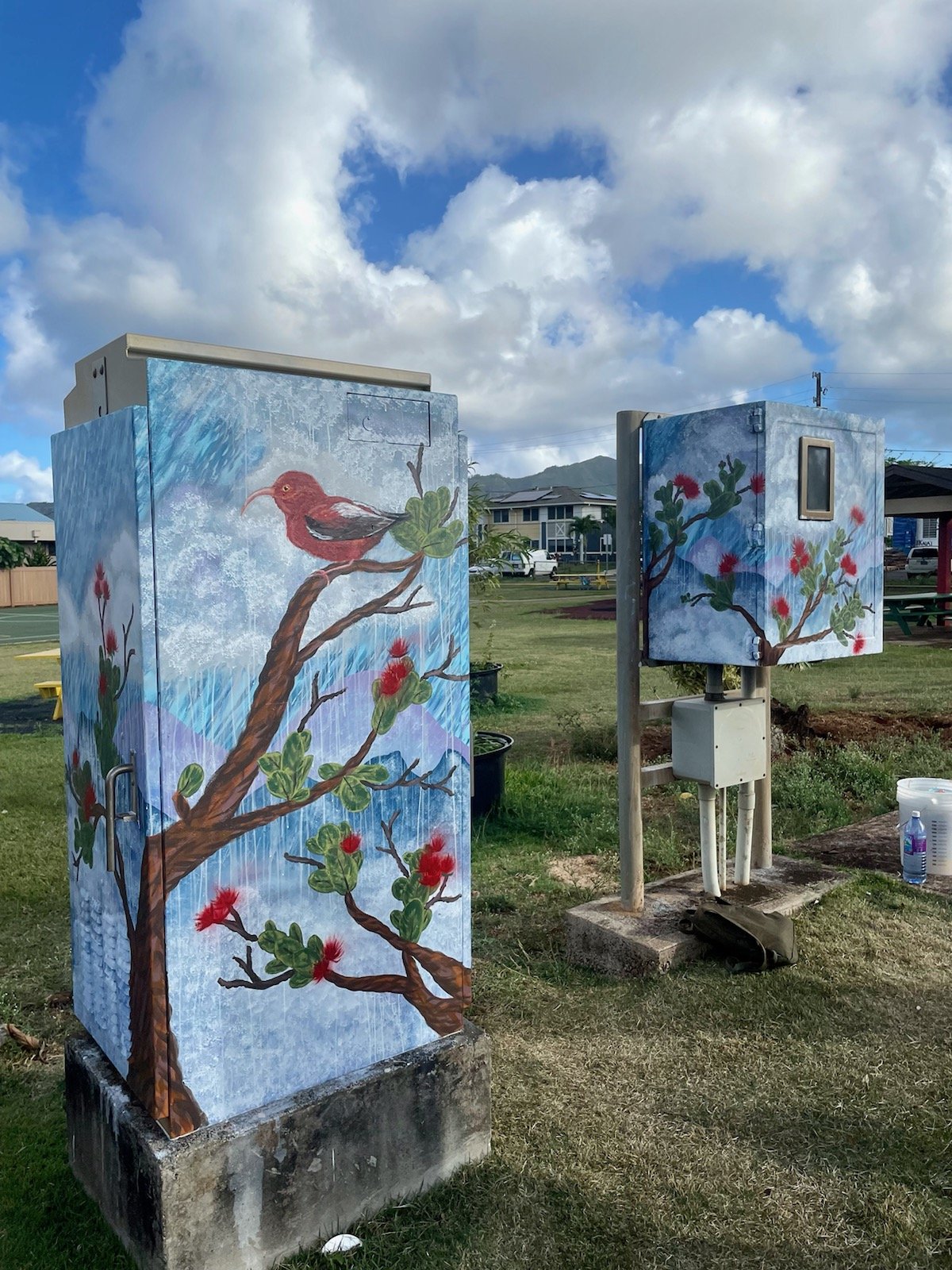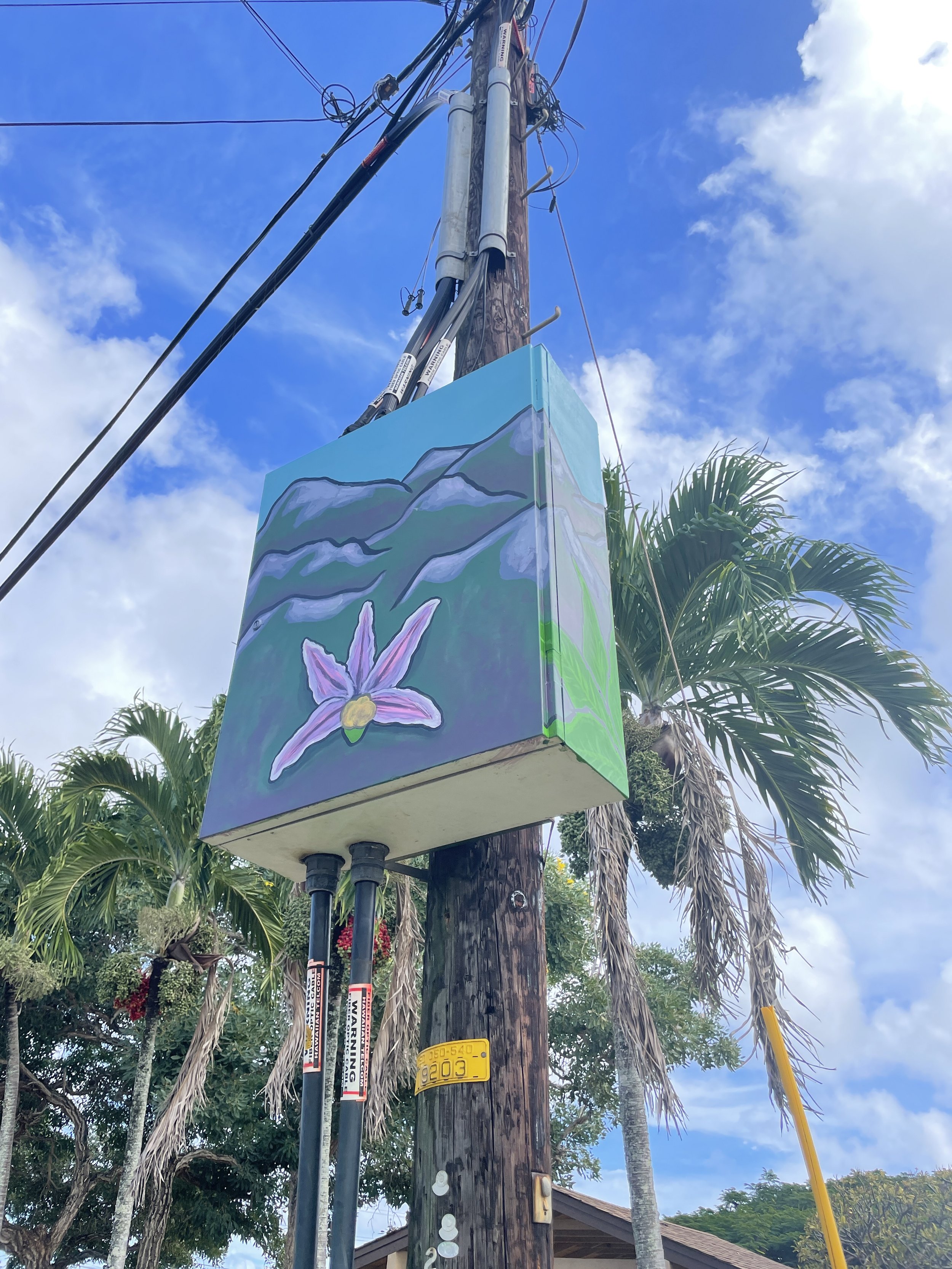
Protect Native Species
Self Guided Mural Tour
The Rice Street Business Association’s (RSBA) Kauai Mural - Protect Native Species Mural - Self-Guided Tour is a public art initiative designed to educate both local community visitors and the about Kauai’s unique and endangered native species through visually compelling murals. Through the integration of art, cultural storytelling, and conservation awareness, the project will create an engaging and self-guided walking tour along Rice Street and surrounding areas of Downtown Līhuʻe.
These electrical boxes along Rice Street in Līhu‘e has been transformed by community effort of the grassroots nonprofits in collaboration with County of Kaua’i and Hawaiian Telcom. These public art pieces are to help raise awareness about endemic plants and animals. Endemic means that these species are found nowhere else in the world. They are vital to sustaining the life of our living creatures (including humans!) here on Kaua‘i. The introduction of foreign plants and animals, foreign diseases, overdevelopment, environmental degradation, and human activity has caused many of these plants and animals to go extinct or be critically endangered causing harm to our natural habitats. These plants and animals are also central to native Hawaiian cultural beliefs and practices as they are thought to be kino lau (body forms) of akua (gods/goddess) that represent the elements and carry mo‘olelo (stories/ narratives/ histories) about sustainability, interconnectedness, and respect for all lifeforms. The vision of this project is if people ‘see’ endemic plants and animals in a town center where they are not seen anymore then people can become more educated and do their part in helping to protect these plants and animals and therefore, protecting Kaua‘i.
We are in our final steps to finalize our self-guided tour for our community. We will be completing 3 more murals, installing QR codes, and finalizing the self-guided tour experience. Mahalo for your support and weʻre excited for you to learn and enjoy the art in Downtown Līhuʻe.
‘Ālula & The Fabulous Moth
This box is on the corner of Rice & Ho‘olako St
Features the extinct Fabulous Green Sphinx Moth (yes, that’s her real name) and the critically endangered ‘Ālula. The Fabulous Green Sphinx Moth is the primary pollinator of ‘Ālula. When the moth went extinct the ‘Ālula population started to decline. The last known naturally occurring ‘Ālula patch is said to be living in the Nā Pali Coast, Kaua‘i.
By: Holly Ka'iakapu
IG: @thehkexperience
Partners: County of Kaua’i, RSBA, Kamāwaelualani
Koa & ‘Elepaio
This box is on the corner of Rice & ‘Umi St. and features the Koa Tree and the ‘Elepaio. The Koa Tree was used by our ancestors to create canoes, housing, weapons, and tools. Koa means “brave” and can also mean “warrior” as Koa Trees are known for their strength, steadfastness, and resiliency. A kānaka maoli (native Hawaiian) saying goes, “E ola koa” or “Live like Koa,” meaning to live in strength and rootedness. Today, the Koa is a precious wood, known for its sturdiness and veneer. The ‘Elepaio bird is endangered due to introduced diseases, human impacts, and foreign predators. The ‘Elepaio can be seen today, if you’re lucky, up in the mountains amongst the Koa trees in Kōke‘e, Kaua‘i. A more common sight than ‘Elepaio and Koa is an ānuenue (rainbow) which is featured on the side of the box.
By: Bethany Coma
IG: @buddah.beth
Partners: County of Kaua’i, RSBA, Kamāwaelualani
‘I‘iwi & ‘Ōhi‘a
This box is on the corner of Rice & Kalena St.
Features the endangered ‘I‘iwi bird and the ‘Ōhi‘a Lehua. The ‘I‘iwi and ‘Ōhi‘a are in a symbiotic relationship. Mo‘olelo (story/ narrative) has it that akua (God/Goddess/Ancestor) of the Volcanos, Pele was jealous that her romantic interest, ‘Ōhi‘a fell in love with another wahine (woman) named Lehua. Out of hurt, she poured lava over the lovers. ‘Ōhia lifted Lehua over his head to protect her. Lehua is now one of the only plants that can grow from lava. The ‘I‘iwi is Lehua’s ‘aumakua (personal/ family god) and is said to be watching over Lehua till this day. Unfortunately, Rapid ‘Ōhi‘a Death (ROD) is quickly causing ‘Ōhi‘a to go extinct. For more info on how to kōkua (help) please visit ‘Ōhi‘a Love.
By: Bree Blake
IG: @bybreeblake
Partners: County of Kaua’i, RSBA, Kamāwaelualani
Naupaka Kahakai
This box is on Kalena & Malama St. and features the Naupaka Kahakai.
The Naupaka flower, according to one mo‘olelo, tells of the the lovers Naupaka and Kaui. Naupaka is the sister of akua Pele, who became jealous of the relationship between Naupaka and Kaui. Pele attempted to kill Naupaka and Kaui, but Naupaka fled to the sea while Kaui fled to the mountains. When they died, flowers bloomed near the shorelines and in the mountains. The Naupaka Kahakai, found near the ocean, is said to be Naupaka and the Naupaka Kuahiwi , found in the mountains, is said to be Kaui. They grow in what looks like half flowers. When joined together it is said that the lovers’ hearts are made whole again.
By: Bree Blake
IG: @bybreeblake
Partners: Hawaiian Tel, RSBA, Kamāwaelualani
Koki‘o Ke‘oke‘o & Koki‘o Ula
This box is on Rice St. in front of Rice Shopping Center.
It features the endemic and endangered Koki‘o ke‘oke‘o and koki ‘o ula. The Koki‘o ke‘oke‘o (native Hawaiian white hibiscuses) are the only species of hibiscuses in the world known to have fragrant flowers. Their petals don’t overlap like the commonly seen hibiscus with large rounded shaped petals.
By: Holly Ka'iakapu
IG: @thehkexperience
Partners: Hawaiian Tel, RSBA, Kamāwaelualani
Lehua Makanoe
This box is on Rice Street across from the Līhu‘e Townhouses.
It features the Lehua Makanoe, a shrub that is endemic to Kaua‘i and specifically the Alaka‘i Swamp area of Kōke‘e. It is critically endangered, but was once used to make lei. To support the conservation of species such as the Lehua Makanoe please make a contribution to organizations such as the KISC, KRCP, and Hui o Laka.
By: Bethany Coma
IG: @buddah.beth
Partners: Hawaiian Tel, RSBA, Kamāwaelualani
ʻAkekeʻe & ʻAkikiki bird
This box is on Kalena St at Kalena Park.
“The ‘Akeke‘e, a small Hawaiian honeycreeper, is notable for its asymmetric bill. Its name was likely derived from the Hawaiian word ke'e, meaning "crooked" or "bent."
The ʻakikiki (Oreomystis bairdi), also called the Kauaʻi creeper, is a critically endangered Hawaiian honeycreeper endemic to Kauaʻi, Hawaiʻi. It is the only member of the genus Oreomystis. Of the Hawaiian birds known to be extant, it is thought to be the most endangered, with only 45 wild individuals known as of 2021.
By: Bethany Coma
IG: @buddah.beth
Partners: Hawaiian Tel, RSBA, Kamāwaelualani
'Alae 'Ula ~ Hawaiian Gallinule (Moorhen)
This box is on the corner of Rice St. and Hale’lani St.
The ‘Alae ‘Ula is an endemic water bird (found naturally only in Hawaii) that is an endangered species with a total population perhaps in the hundreds.
According to Hawaiian legend, the gallinule brought fire from the volcano home of the gods to the Hawaiian people. During his flight, the gallinule’s formerly white forehead was burned red by the volcanos’ fire.
By: Holly Ka'iakapu
IG: @thehkexperience
Partners: Hawaiian Tel, RSBA, Kamāwaelualani
Naupaka Kuahiwi
This box is on the corner of Rice St. and Malama St. at Kalena Park.
There are several Hawaiian legends that tell the origin of the beach and mountain forms of naupaka, both of which produce these unusual half-flowers. In one version, a princess was forbidden to marry her true love, a fisherman, because he was a commoner. As they parted ways forever, she tore a flower in half, giving one half to him and keeping the other half for herself. She then returned to the mountains where her family lived. Broken-hearted, they both cried and planted their halves of the flower. Each half grew and became the two forms of naupaka – the beach naupaka (naupaka kahakai) and the mountain naupaka (naupaka kuahiwi).
By:Bree Blake
IG: @bybreeblake
Partners: Hawaiian Tel, RSBA, Kamāwaelualani
The RSBA’s Kauai Murals Native Species Self-Guided Mural Tour celebrates Hawaii’s rich biodiversity through public art, highlighting native plants and animals while fostering community engagement and education. You can support this initiative by:
Sponsoring a Mural – Contribute funds to commission new murals featuring native species.
Promoting the Tour – Share the tour with visitors and locals through social media, websites, and newsletters.
Volunteering – Assist with mural maintenance, tour development, or educational outreach.
Donating – Provide financial support to sustain and expand the project.
Partnering – Collaborate with RSBA to integrate the tour into cultural and environmental programs.
Your support helps preserve Kauai’s natural heritage and enhances the island’s public art landscape.









